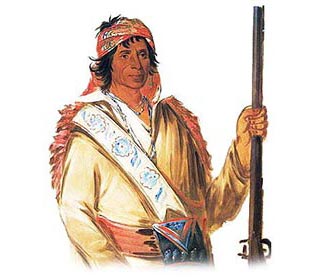Fast Facts about the History of Florida Indians
The climate, land, history, environment and natural resources that were available to the indigenous Indian tribes in Florida resulted in the adoption of the Southeast culture. - Name of State: Florida
- Meaning of State name: Spanish for the word 'flowery'. Juan Ponce de Leon called the area "la Florida" in honor of Spain's Easter celebration "Pascua florida" (feast of the flowers).
- Geography, Environment and Characteristics of the State of Florida: Land is mainly flat with rolling hills in northwest
- Culture adopted by Florida Indians: Southeast Cultural Group
- Languages: Muskogean
- Way of Life (Lifestyle): Hunter gatherers, fishers and hunter farmers
- Types of housing, homes or shelters: Asi Wattle and Daub houses
History Timeline of the Florida Indians - 10,000 BC: The first indigenous people were of the Paleo-Indian culture who lived in caves or were Nomadic Hunters
- 7000 BC: Archaic Period in which people built basic shelters and made stone weapons and stone tools
- 2500 BC: Gulf Formational Period of the Southeast culture group with development of ceramics and pottery
- 1000 AD: Woodland period with permanent houses and farming
- 1513: Juan Ponce de Leon became the first European to explore Florida. He claimed Florida for Spain but was unable to establish a colony due to Indian attacks.
- 1539: Hernando de Soto landed in the Tampa Bay and explored central and northern Florida
- 1564: French missionaries settled Fort Caroline near present-day Jacksonville
- 1565: Spanish troops drove the French out of Florida and established St. Augustine, the first permanent European settlement
- 1763: Great Britain gained control of Florida
- 1687: The Spanish attempted to send Yamasees to the West Indies as slaves which resulted in the tribe rebelling against the Spanish missions. The Yamasee tribe moved into South Carolina
- 1702: (1702-1713) Queen Anne's War (part of the French and Indian Wars) between the French and Spanish colonies allied with the Wabanaki Confederacy, Mohawk, Choctaw, Timucua, Apalachee and Natchez tribes against the British colonies allied with the Muscogee (Creek), Chickasaw and Yamasee tribes.
- 1754: 1754 - 1763: The French Indian War is won by Great Britain against the French so ending the series of conflicts known as the French and Indian Wars
- 1763: Treaty of Paris
- 1775: 1775 - 1783 - The American Revolution.
- 1776: July 4, 1776 - United States Declaration of Independence
- 1803: The United States bought the Louisiana Territory from France for 15 million dollars for the land
- 1812: 1812 - 1815: The War of 1812 between U.S. and Great Britain, ended in a stalemate but confirmed America's Independence
- 1813: 1813 - 1814 - The first Creek Indian War (Seminole War), also known as the Red Stick War. The US was pulled into the conflict in Pensacola, Florida at the Battle of Burnt Corn
- 1822: The US government offered land in Oklahoma to the Seminole Indians. Many refused to leave and fought for their lands.
- 1830: Indian Removal Act
- 1832: Department of Indian Affairs established
- 1832: 1832-1839: Removal of the Seminole, Cherokee, Chickasaw, Choctaw and Creek Indians, known as the "Five Civilized Tribes" to Indian Territory on the Trail of Tears
- 1836: 1836 - 1837 - The Second Creek War (Seminole War). The Seminole Wars killed many of the Indians and forced all but a few out of Florida.
- 1861: 1861 - 1865: The American Civil War.
- 1862: U.S. Congress passes Homestead Act opening the Great Plains to settlers
- 1865: The surrender of Robert E. Lee on April 9 1865 signalled the end of the Confederacy
- 1887: Dawes General Allotment Act passed by Congress leads to the break up of the large Indian Reservations and the sale of Indian lands to white settlers
- 1969: All Indians declared citizens of U.S.
- 1979: American Indian Religious Freedom Act was passed
History of Florida Indians - Destruction and Decline
The history of the European invasion brought epidemic diseases such as tuberculosis, cholera, influenza, measles and smallpox. The Native Indians of Florida had not developed immunities against these diseases resulting in huge losses in population. Exploitation including the leverage of taxes, enforced labor and enslavement were part of their history, taking their toll on the Florida Indians. |
